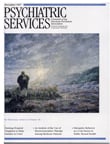Clinical Prediction of Assaultive Behavior Among Male Psychiatric Patients at a Maximum-Security Forensic Facility
Abstract
OBJECTIVE: Patient characteristics associated with the clinical prediction of assaultive behavior in a forensic psychiatric hospital were compared with characteristics associated with actual assaultive behavior. METHODS: Treating psychiatrists at a New York forensic psychiatric hospital were asked to predict which of a sample of 183 recently admitted male patients were likely to show assaultive behavior during a three-month period. The predictions were compared with incident reports of actual assaultive behavior. Several patient characteristics, including race, legal status, age, education, criminal history, psychiatric symptoms rated independently by raters other than the treating psychiatrists, and ward behavior, were examined for their association with predicted and actual assaultive behavior. RESULTS: Clinicians' rate of correct prediction of assaultive behavior was 71 percent, with a diagnostic sensitivity of 54 percent and a diagnostic specificity of 79 percent. Characteristics associated with the prediction of assaultive behavior were race, transfer from a civil facility because of violence or dangerousness, age, education, arrests for violent offenses, childhood physical abuse, hostility, temper (or nurses' assessment of the patient's irritability), and inability to follow ward routine. Characteristics associated with actual assaultive behavior were transfer from a civil hospital, dual diagnosis of schizophrenia and substance abuse or dependence, childhood physical abuse, age, thought disorder, and temper. CONCLUSIONS: Clinicians were significantly more accurate than chance in prospectively predicting which male forensic patients would show assaultive behavior. However, some of the factors associated with clinical prediction, such as race, ability to follow ward routine, and arrest history, were not associated with actual assaultive behavior. In addition, clinicians failed to use dual diagnosis of schizophrenia and substance use disorder as a predictor.



